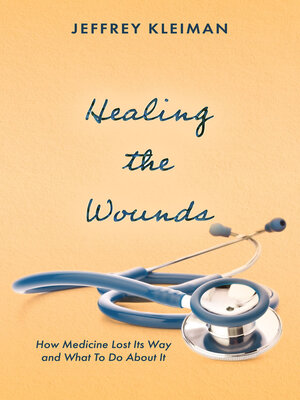
Sign up to save your library
With an OverDrive account, you can save your favorite libraries for at-a-glance information about availability. Find out more about OverDrive accounts.
Find this title in Libby, the library reading app by OverDrive.



Search for a digital library with this title
Title found at these libraries:
| Loading... |
"To the typical physician, my metastatic cancer is a routine incident in his (her) rounds, while for me it's the crisis of my life. I would feel better if I had a doctor who at least perceived this incongruity." wrote author Antole Broyard.
Medicine in the United States is widely regarded as the best in the world. Hardly a day passes without a major scientific breakthrough. Many formerly fatal diseases are now curable. People are healthier and live longer than ever. Still, patient dissatisfaction with doctors has rarely been more acute. Although physicians are increasingly able to cure disease and prolong life, the American public is suspicious, distrustful of, even antagonistic to the profession. Doctors universally acknowledge a crisis in healthcare. With the focus on colossal medical expenditures, amounting to trillions annually, most of the numerous solutions involve containing runaway costs. This book, Healing the Wounds, reaches a different conclusion about what is ailing our healthcare system.
Medicine's profound crisis is only partially related to ballooning costs, for the problem is far deeper than economics. The basic reason is that medicine has lost its way, if not its soul. An unwritten covenant between doctor and patient made over several millennia is being broken.
At midcentury a doctor's image outshone nearly every other profession. Yet it appears that with each new medical miracle, the image of physicians shrinks and grows more tarnished.
No significant transformation results from a single or simple cause. Reflecting on forty-one years of medical practice, I see that something vital appears to be vanishing. A three thousand year tradition, which bonded doctor and patient in a special affinity of trust, is being traded for a new type of relationship. Healing is replaced with treating, caring is supplanted by managing, the art of listening is taken over by technologic procedures. Doctors no longer minister to a distinctive person but concern themselves with fragmented malfunctioning biological parts. The distressed human being is frequently absent from the transaction.
The introduction of increasingly sophisticated technology is certainly one reason. Compared with the sharp images provided by CAT scans, MRIs, endoscopy, and angiography, a patient's history is flabby, confused, subjective, and seemingly irrelevant. Furthermore, it takes a good deal of time to elicit a full history. According to some doctors, technology has become a sufficient substitute for talking with patients.
And, what about the lost art of the physical exam? The old-fashioned touching, looking and listening — the once prized, almost magical skills of the doctor who missed nothing and could swiftly diagnose a peculiar walk, sluggish thyroid or leaky heart valve using just keen eyes, practiced hands and a stethoscope and reflex hammer.
Society places a much higher premium on technology than on examining, listening or counseling. Time spent in the operating room or performing an invasive procedure is rewarded tenfold more than conversing with patients or family. In addition to obviating discourse, current medical practice focuses on the acute and emergent and is largely indifferent to preventing disease and promoting health. The rot will continue until doctors reconnect with their tradition as healers.
"Healing the Wounds" attacks the issues from multiple perspectives. Patient experience and stories are the core starting points. The book explores physician burnout and frustration. It compares different world wide healthcare systems. Finally it suggests solutions for a better future for all.






